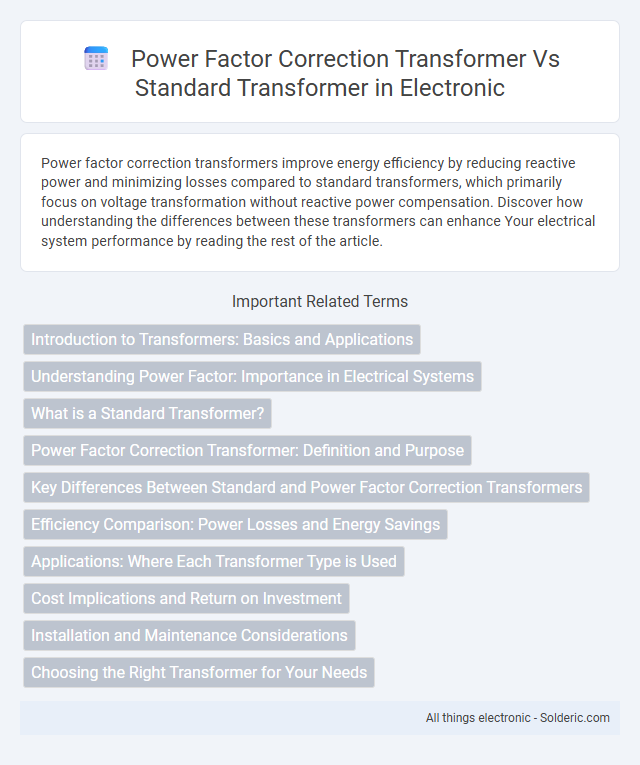Power factor correction transformers improve energy efficiency by reducing reactive power and minimizing losses compared to standard transformers, which primarily focus on voltage transformation without reactive power compensation. Discover how understanding the differences between these transformers can enhance Your electrical system performance by reading the rest of the article.
Comparison Table
| Feature | Power Factor Correction Transformer | Standard Transformer |
|---|---|---|
| Purpose | Improves power factor by compensating reactive power | Transfers electrical energy between circuits without power factor correction |
| Reactive Power Compensation | Yes, integrated for reducing reactive power | No, does not compensate reactive power |
| Efficiency | Higher overall system efficiency due to reduced losses | Standard efficiency, does not optimize power factor |
| Applications | Industrial and commercial settings with inductive loads | General electrical power transfer in various applications |
| Cost | Higher initial cost due to additional components | Lower cost, simpler design |
| Complexity | More complex design with integrated capacitors or reactors | Simple winding and core structure |
| Power Quality Impact | Improves power quality by reducing harmonic distortion and improving voltage stability | No significant impact on power quality |
Introduction to Transformers: Basics and Applications
Power factor correction transformers specifically enhance the power factor by reducing reactive power and improving system efficiency, unlike standard transformers that primarily transfer electrical energy without optimizing power quality. These transformers are vital in industrial settings where inductive loads cause low power factor issues, leading to increased losses and higher electricity costs. Incorporating power factor correction transformers helps maintain voltage stability and reduces demand charges, boosting overall electrical system performance.
Understanding Power Factor: Importance in Electrical Systems
Power factor correction transformers improve electrical efficiency by reducing reactive power and minimizing energy losses, unlike standard transformers that do not address power factor issues. Understanding power factor is crucial because it measures how effectively electrical power is used, directly affecting your utility costs and system stability. Implementing power factor correction transformers helps optimize your electrical system's performance and reduces the risk of overloads and penalties from utility providers.
What is a Standard Transformer?
A standard transformer is an electrical device designed to transfer power between circuits through electromagnetic induction, primarily focusing on voltage transformation without altering power factor. It consists of primary and secondary coils wound on a magnetic core, allowing efficient voltage step-up or step-down based on turns ratio. Unlike power factor correction transformers, standard transformers do not include components or circuitry to improve the power factor of the load connected to the system.
Power Factor Correction Transformer: Definition and Purpose
A Power Factor Correction (PFC) transformer is designed to improve the efficiency of electrical systems by minimizing reactive power and enhancing the power factor, which reduces energy losses. Unlike standard transformers that solely step voltage up or down, PFC transformers incorporate specialized windings or components to counteract inductive loads. Your electrical network benefits from increased stability and lower utility charges by integrating PFC transformers in applications with motors, capacitors, or non-linear loads.
Key Differences Between Standard and Power Factor Correction Transformers
Power factor correction transformers differ from standard transformers primarily in their design and functionality to improve energy efficiency by correcting the power factor in AC electrical systems. They incorporate specialized winding configurations and components to compensate for reactive power, reducing losses and enhancing voltage stability, while standard transformers simply transfer electrical energy without addressing power factor issues. These transformers play a critical role in industrial applications with inductive loads, helping to lower utility charges and improve overall system performance.
Efficiency Comparison: Power Losses and Energy Savings
Power factor correction transformers reduce power losses by improving the power factor, leading to enhanced system efficiency compared to standard transformers. Lower reactive power flow minimizes energy wastage, resulting in significant energy savings and reduced operational costs. Your electrical system benefits from optimized load management and decreased heat generation, extending equipment lifespan.
Applications: Where Each Transformer Type is Used
Power factor correction transformers are primarily utilized in industrial and commercial settings where electrical loads cause low power factors, such as manufacturing plants, data centers, and large HVAC systems, to improve energy efficiency and reduce utility penalties. Standard transformers are commonly used in general electrical distribution, residential power supply, and less complex industrial applications where power factor issues are not a primary concern. Your choice between these transformers depends on the nature of your electrical system and the need to optimize power quality and reduce energy costs.
Cost Implications and Return on Investment
Power factor correction transformers typically have higher initial costs compared to standard transformers due to their specialized design aimed at improving efficiency and reducing energy losses. Your investment often yields significant long-term savings by lowering electricity bills and avoiding penalties from poor power factor in commercial and industrial applications. Evaluating the return on investment requires considering energy cost reductions, maintenance savings, and potential incentives for energy-efficient equipment.
Installation and Maintenance Considerations
Power factor correction transformers require precise installation to handle reactive power efficiently, often involving additional capacitors and control equipment compared to standard transformers. Maintenance for these transformers focuses on monitoring capacitive elements and ensuring optimal tuning to prevent harmonic distortions, which is less critical in standard transformers. Your choice between these transformers should consider the complexity and frequency of maintenance tasks alongside installation requirements specific to power factor correction needs.
Choosing the Right Transformer for Your Needs
Selecting the right transformer depends on your specific power quality requirements and system efficiency goals. Power factor correction transformers are engineered to minimize reactive power, helping to improve energy efficiency and reduce utility penalties, whereas standard transformers primarily focus on voltage regulation without correcting power factor. Evaluating your load characteristics and electricity cost implications ensures that you choose a transformer that optimizes performance and savings.
power factor correction transformer vs standard transformer Infographic

 solderic.com
solderic.com